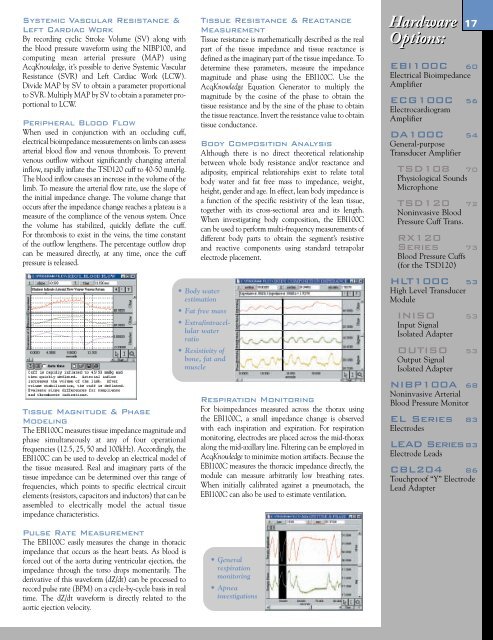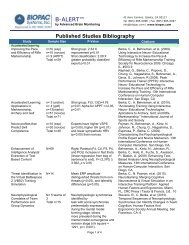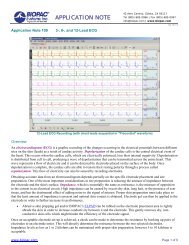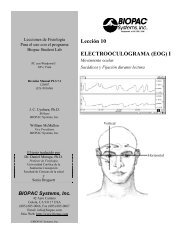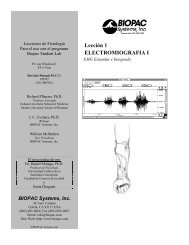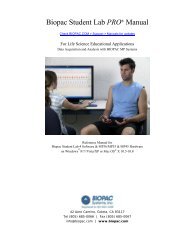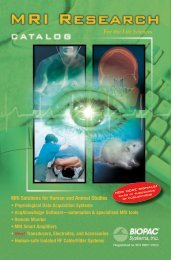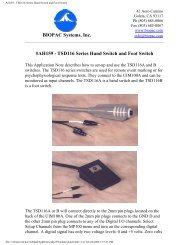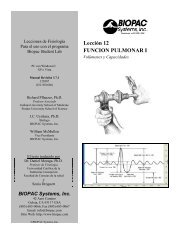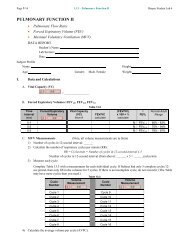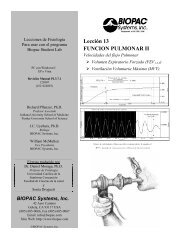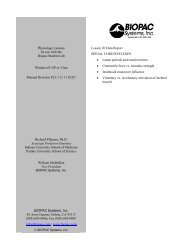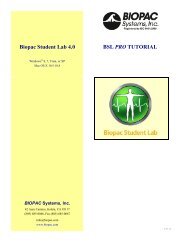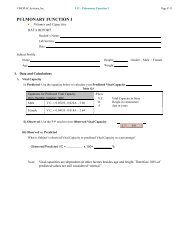MP Research Catalog - Biopac
MP Research Catalog - Biopac
MP Research Catalog - Biopac
- No tags were found...
You also want an ePaper? Increase the reach of your titles
YUMPU automatically turns print PDFs into web optimized ePapers that Google loves.
Systemic Vascular Resistance &Left Cardiac WorkBy recording cyclic Stroke Volume (SV) along withthe blood pressure waveform using the NIBP100, andcomputing mean arterial pressure (MAP) usingAcqKnowledge, it’s possible to derive Systemic VascularResistance (SVR) and Left Cardiac Work (LCW).Divide MAP by SV to obtain a parameter proportionalto SVR. Multiply MAP by SV to obtain a parameter proportionalto LCW.Peripheral Blood FlowWhen used in conjunction with an occluding cuff,electrical bioimpedance measurements on limbs can assessarterial blood flow and venous thrombosis. To preventvenous outflow without significantly changing arterialinflow, rapidly inflate the TSD120 cuff to 40-50 mmHg.The blood inflow causes an increase in the volume of thelimb. To measure the arterial flow rate, use the slope ofthe initial impedance change. The volume change thatoccurs after the impedance change reaches a plateau is ameasure of the compliance of the venous system. Oncethe volume has stabilized, quickly deflate the cuff.For thrombosis to exist in the veins, the time constantof the outflow lengthens. The percentage outflow dropcan be measured directly, at any time, once the cuffpressure is released.• Body waterestimationTissue Resistance & ReactanceMeasurementTissue resistance is mathematically described as the realpart of the tissue impedance and tissue reactance isdefined as the imaginary part of the tissue impedance. Todetermine these parameters, measure the impedancemagnitude and phase using the EBI100C. Use theAcqKnowledge Equation Generator to multiply themagnitude by the cosine of the phase to obtain thetissue resistance and by the sine of the phase to obtainthe tissue reactance. Invert the resistance value to obtaintissue conductance.Body Composition AnalysisAlthough there is no direct theoretical relationshipbetween whole body resistance and/or reactance andadiposity, empirical relationships exist to relate totalbody water and fat free mass to impedance, weight,height, gender and age. In effect, lean body impedance isa function of the specific resistivity of the lean tissue,together with its cross-sectional area and its length.When investigating body composition, the EBI100Ccan be used to perform multi-frequency measurements ofdifferent body parts to obtain the segment’s resistiveand reactive components using standard tetrapolarelectrode placement.• Fat free mass• Extra/intracellularwaterratio• Resistivity ofbone, fat andmuscleHardwareOptions:17EBI100C 60Electrical BioimpedanceAmplifierECG100C 56ElectrocardiogramAmplifierDA100C 54General-purposeTransducer AmplifierTSD108 70Physiological SoundsMicrophoneTSD120 72Noninvasive BloodPressure Cuff Trans.RX120Series 73Blood Pressure Cuffs(for the TSD120)HLT100C 53High Level TransducerModuleINISO 53Input SignalIsolated AdapterOUTISO 53Output SignalIsolated AdapterTissue Magnitude & PhaseModelingThe EBI100C measures tissue impedance magnitude andphase simultaneously at any of four operationalfrequencies (12.5, 25, 50 and 100kHz). Accordingly, theEBI100C can be used to develop an electrical model ofthe tissue measured. Real and imaginary parts of thetissue impedance can be determined over this range offrequencies, which points to specific electrical circuitelements (resistors, capacitors and inductors) that can beassembled to electrically model the actual tissueimpedance characteristics.Pulse Rate MeasurementThe EBI100C easily measures the change in thoracicimpedance that occurs as the heart beats. As blood isforced out of the aorta during ventricular ejection, theimpedance through the torso drops momentarily. Thederivative of this waveform (dZ/dt) can be processed torecord pulse rate (BPM) on a cycle-by-cycle basis in realtime. The dZ/dt waveform is directly related to theaortic ejection velocity.Respiration MonitoringFor bioimpedances measured across the thorax usingthe EBI100C, a small impedance change is observedwith each inspiration and expiration. For respirationmonitoring, electrodes are placed across the mid-thoraxalong the mid-axillary line. Filtering can be employed inAcqKnowledge to minimize motion artifacts. Because theEBI100C measures the thoracic impedance directly, themodule can measure arbitrarily low breathing rates.When initially calibrated against a pneumotach, theEBI100C can also be used to estimate ventilation.• Generalrespirationmonitoring• ApneainvestigationsNIBP100A 68Noninvasive ArterialBlood Pressure MonitorEL Series 83ElectrodesLEAD Series 83Electrode LeadsCBL204 86Touchproof “Y” ElectrodeLead Adapter


